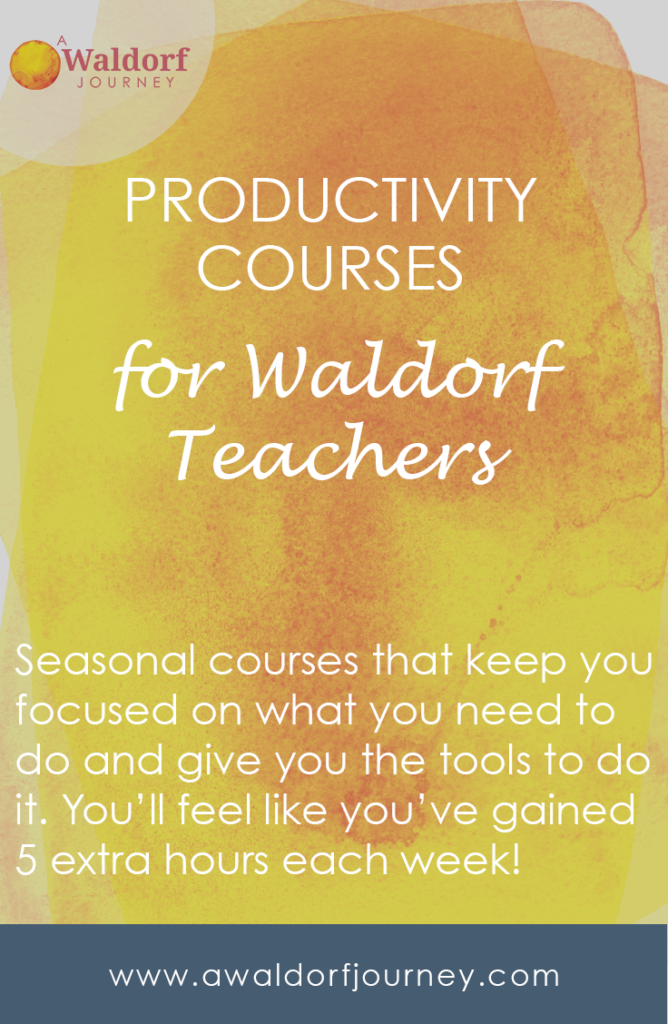Think back. Why did you become a teacher?
If you’re like most Waldorf teachers, you chose this profession because you love learning new things, love inspiring children to learn and appreciate the creative expression you get to indulge in with every main lesson.

Odds are, you were not thinking about the innumerable administrative and organizational tasks that come along with being a Waldorf teacher.
When I first started teaching I was positively inspired as I prepared every main lesson.
I loved thinking about how my students would respond to the content and how they would best absorb the material.
My mind was awash with stories, drawings, creative writing assignments and lively experiences that would help the concepts we were learning come to life. That enthusiasm for our lessons and watching the lightbulbs switch on in my students’ eyes is still my favorite thing about being a teacher.

But back then I completely overlooked the OTHER, very important part of teaching.
I hardly considered the more mundane aspects of being a teacher. Things like . . .
- Record-keeping
- Writing reports
- Communicating with parents
- Creating a reading and math practice program
- Writing a classroom management plan
- Writing individual student success plans
- Facilitating outside testing
The list goes on and on.
I didn’t want to focus on these things. Life in the classroom was the most interesting aspect of my work, so I completely ignored the rest of it. I found all of those things stressful and frankly, exhausting. I sometimes resented parents, colleagues and tasks that took my attention away from the good work I was doing in the classroom.
In those early days I put all of my teacher eggs in one basket — main lesson. Sometimes I thought about those other things that I was overlooking, but I hardly had time to consider them so I thought that if I just crafted the perfect main lesson plan, all those other things would resolve themselves.
Inevitably, those neglected tasks came back to bite me in the end. And because of it my teaching life was a LOT harder than it needed to be.
I gave hours and hours of my life to planning my lessons, but it just never seemed to be enough.
Well, I’ve learned a lot since those days, and it’s a good thing, because the demands have increased 10-fold. There is a lot of pressure on teachers, parents and students to make sure that skills are developing and everything is well-documented.
These days, in my mentoring work with teachers, I find that many of us struggle with the same thing. Waldorf teachers are creative, enthusiastic individuals who love to inspire their students with meaningful lessons. And we can all agree that this is the most important aspect of our work.
But we can’t neglect the other stuff. And there’s A LOT of other stuff. Even when we recognize the other things that need our attention, we can’t find the time to get to them!
Finding Time for Everything
As a result, I’ve found that teachers just keep on going, plugging ahead with their inspiring lessons, ignoring the nagging feeling that there is something else they should be doing. Before long, the pressure of those unattended tasks builds up and eventually the volcano erupts. Parents, administration, students and teacher all suffer and scramble to repair the damage.
Now, almost every Waldorf teacher I’ve ever met has said that having more hours in the day would go a long way towards resolving these woes. And if our Waldorf teacher dreams came true we would have a couple more hours to attend to these tasks (and maybe even sleep!)
But I’ve found that having a well-formed plan and a rhythm for addressing all of these extra tasks is almost as good as adding hours to the day. When teachers implement a rhythm for tracking and completing these tasks their productivity skyrockets and they feel as though they suddenly have MORE TIME!
93% of surveyed Waldorf teachers identified lack of time as their greatest challenge.
That’s where A Waldorf Journey’s Productivity Courses come in.
Each seasonal 6-week productivity course addresses those topics that need your attention and gives you all of the tools you need to do it. Included with every course you’ll receive . . .
Weekly Emails
Weekly emails arrive in your inbox at the beginning of the week, helping you identify where your attention needs to go each week and giving you goals to guide the work.
PDF Downloads
Depending on the topic, you’ll receive pdf downloads to help accomplish tasks. Record-keeping documents, self-evaluation forms, end-of-year report templates, parent communication scripts — all of these are just a sampling of the documentation that will help keep your work as productive as possible.
Email Support
Getting stuck on a task? Want to make sure you’re on the right track? Answers are just an email away.
Colleague Support
Though not an official part of the program, enrolled teachers can join a private Facebook group and tap into the support of a cohort of participating teachers. In previous programs, this has been a hugely valuable component of the program and teachers have enjoyed working through tasks together.
The 6-week courses run seasonally and content varies according to the season.
- Spring — Record-keeping, Report-Writing, Parent-Teacher Conferences, Professional Development Planning, Student Assessment
- Summer — Curriculum Planning, Classroom Preparation, Student Observation, Purchasing Supplies, Parent Communication, Classroom Management
- Fall — Classroom Rhythms and Routines, Classroom Management #1 Engagement, Classroom Management #2 Discipline, Imagination in the Classroom, Working with Parents, Working with Students
These three programs are designed to help you make sure that you’re attending to everything and not overlooking something important. It’s like another set of hands to keep all the juggling balls in the air.
With support like this you’ll feel like you have more time, you’re on top of any challenges that arise and you’ll be able to address them quickly and easily — before they turn into an erupting volcano.
Would you pay for 5 extra hours per week? Yeah, me too.
Enrollment is $197/term and includes one A Waldorf Journey curriculum guide.
- Spring — The 30 Days Till Summer Report Writing Challenge
- Summer — Curriculum guide of your choice
- Fall — Guide to Record-Keeping
And if you’re unsatisfied, you can receive a full refund if you request by the end of week 2 of the program.
Enrollment is currently open for my fall course. Sign up today!




